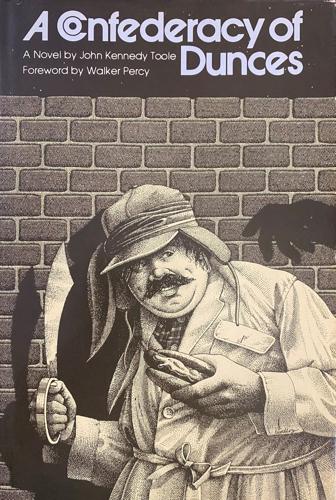In a world rife with shortages of all kinds, New Orleans writers have constituted a renewable — and continually renewing — resource for nearly all of the city’s 305 years.
“Literary New Orleans,” WYES-TV’s latest documentary, wisely doesn’t attempt to deliver pat answers to explain this phenomenon — there aren’t any — but several interviewees offer suggestions, including the city’s laid-back lifestyle, a culture steeped in storytelling and the stimulating, symbiotic presence of other writers.
What the hourlong program definitely does offer is nothing less than a breathtaking, fast-moving survey of the literature that New Orleans has inspired, over and over again, throughout its history, starting with the diary of Marc-Antoine Caillot, an 18th-century French shipping clerk, and continuing with such literary luminaries as Mark Twain, Tennessee Williams, Grace King, Walker Percy, Anne Rice, Tom Dent and John Kennedy Toole.
Along the way, the program examines the works of gay writers, Black writers, Beat writers, feminist writers and folks who write about the power of music and Hurricane Katrina.
Its premiere is Thursday at 7 p.m. on WYES. It will be streamed live at wyes.org and available on WYES and PBS apps. Future airdates are at wyes.org.
Subjective study
“Literary New Orleans” isn’t an in-depth study, nor is it intended to be, because such an undertaking would require years. And there are omissions because — face it — all lists are inherently subjective.
Nevertheless, there is much to savor here. Diligent research has brought forth photographs, pictures of beautifully bound books and video gems that leave the viewer wanting more.

John Kennedy Toole's 'A Confederacy of Dunces,' was published after his death thanks to a relentless campaign by his mother, Thelma.
In the video category, I especially enjoyed Eric Paulsen’s interview with Williams, who extolled New Orleans’ “more congenial climate”; Rice’s discussion of the way she wrote her first vampire novel; and footage of Thelma Toole, John Kennedy Toole’s mother, who was responsible for getting “A Confederacy of Dunces” published and, when it was a sensation, became a Norma Desmond-like character, dressed to the nines in gloves and a hat, who loved the limelight.
And then there’s W. Kenneth Holditch’s almost-too-good-to-be-true account of Williams’ creation of “A Streetcar Named Desire” in a French Quarter attic apartment where he could hear that eponymous streetcar clattering in one direction and a streetcar called Cemeteries running the other way. It seemed “an ideal metaphor for the human condition,” said Holditch, a professor at the University of New Orleans who died in 2022, and it provided Williams with the inspiration for the title of his most famous play.
You just can’t find this stuff in other cities, and this program revels in that fact.
'This is Mardi Gras'
And then there’s the city itself. Consider Twain’s description to his sister of his arrival in New Orleans on a March day in 1859: “I saw a hundred men, women and children in fine, fancy, splendid, ugly, coarse, ridiculous, grotesque, laughable costumes, and the truth flashed upon me: This is Mardi Gras.”
Nearly 70 years later, Sherwood Anderson, a proud son of Ohio, fell for New Orleans so hard that he moved into a French Quarter apartment in 1924 and beckoned fledgling scribes to the Crescent City, including William Faulkner, Carl Sandburg, Thomas Wolfe and Lyle Saxon.
Such stories just keep coming in this program.
Not every writer is as famous as Twain, Williams or Toole, and “Literary New Orleans” does a good job in calling attention to such scribes as George Washington Cable, Lafcadio Hearn and Charles Gayarré.
It also praises the Federal Writers’ Project, a New Deal agency that was part of the Works Progress Administration, that put writers around the country to work in the late 1930s doing what they did best — writing — to compose a series of guidebooks covering every state and some major cities, including New Orleans.
Long line of literature
Although segregation was the rule, Saxon, the writers’ project’s local leader, hired Marcus Christian — a Black poet, printer, folklorist and activist — to lead a team that would focus on Black New Orleans for the city’s guidebook.

Louisiana poet laureate Mona Lisa Saloy, left, is featured in the documentary hosted by Peggy Scott Laborde of WYES.
Discussing Christian’s multifaceted life is Mona Lisa Saloy, Louisiana’s poet laureate, who is one of several knowledgeable souls who not only talk about individual writers but also show how they fit into the long line of literature emanating from New Orleans.
Other commentators include Holditch; T.R. Johnson, a professor of English at Tulane University; Nancy Dixon, a professor of English at Dillard University; Rien Fertel, a writer and teacher; Douglas Brinkley, a history professor at Rice University who used to teach at UNO and Tulane; the novelist Maurice Carlos Ruffin; and Susan Larson, Times-Picayune contributor and former books editor who hosts “The Reading Life” on WWNO-FM.
In addition to appreciating their ability to put writers and books into context, I enjoyed watching Larson and Dixon get excited when they talk about the impact that books can have.
And Saloy provides this lovely bit of optimism: “I’m hopeful about the future of Louisiana writers, Louisiana voices and especially New Orleans voices. … We have another generation of writers who are picking up the mantle and are embracing the uniqueness that we are, and giving us so much hope.”




